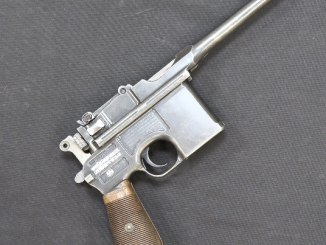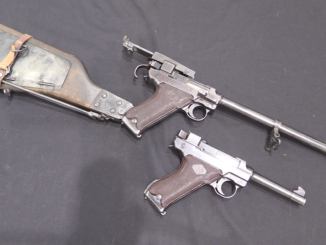RIA’s catalog page for this SMG (transferrable)
Designed by Aimo Lahti, the Suomi m/31 submachine gun is in my opinion one of the standout submachine guns of the World War Two era. Despite its hefty weight (10.4lb / 4.7kg) and lack of a good pistol grip stock, it still manages to be tremendously controllable and accurate, with a very high rate of fire (about 900 rpm).
For a detailed written description of the history and development of the weapon, I would refer you to the excellent article by Jaeger Platoon.




“very high rate of fire (about 900 rpm).”
Combined with fact that SUOMI has build-in pneumatic Rate-of-Fire reducer, this spawn following question:
1) is ~900 rpm value right? Strelkovove orugie (1947) give Rate of Fire as 700 rpm
2) how effective is said Rate-of-Fire reducer? or in others words: what would be Rate of Fire without it?
3) what is mass of moving parts?
Daweo: It was supposed to work pneumatically. Bolt has fine tolerances in the tube/receiver, and after bolt started to move forward again there was a spingloaded valve consisting of a thin brass washer acting as a brake for air trying to enter the tube. Notice the holes on the endplug screwed to the receiver, thats where the air was going in.
Effectiveness? Frankly, I do not know – you hear 2 versions of things i.e. works or not. It wasn’t removed anyway so it supposedly did something.
I’ve found the weight to be almost unmanageable with the 71 round drum magazine even with a sling. Apparently one use during the Winter War was to cross country ski behind Soviet lines and then rush through the Red Army night camp shooting on the way back to the Finnish lines. I am a fairly good downhill skier and doubt if I could manage this feat.
Loading the drum is not something I would want to try and do in the mud and muck of field conditions. Given the impressive reputation, it must be both more accurate and more reliable and contemporary weapons.
“more accurate”
Assuming that Rate-of-Fire reducer actually worked and taking in account it was API weapon:
http://modernfirearms.net/en/submachine-guns/finland-submachine-guns/suomi-m31-eng/
Together with high actual rate-of-fire moving parts must be light, especially in relation to mass of whole weapon, so it should be quite stable during full-auto fire. Muzzle device should also be helping (though not all examples made have this feature).
“weight to be almost unmanageable with the 71 round drum magazine”
High mass is often encountered in case of drum magazines for sub-machine gun, but this is price you have to paid for bigger capacity.
Heavy magazines with high capacity… This is why I said trying to replace the Chauchat with the Lewis gun as an ASSAULTING automatic weapon was a bad idea (namely that the relatively lightweight Chauchat was intended to fire ON THE SPRINT while the Lewis gun, which weighed about 28 pounds with the heavy cooling shroud and pan magazine, had to be set up on its bi-pod before firing, as its intended role was temporary static defense). Drum magazines also need to be wound up before use, if I’m not mistaken.
“Lewis gun(…)ASSAULTING”
For lighter derivative of Lewis machine gun see Solely gun:
http://augfc.tumblr.com/post/170222741740/british-submachine-gun-trials-1915-1939
(1st photo from bottom)
Muzzle brake did less than nothing. That is why it was removed.
I have one of the semiauto rebuild versions… Maybe even more so than the design issues inherent to the conversion, the problems with them are a result of them having been built to a relatively low price point. Mine took a lot of tweaking to make it work acceptably well, and even so most of the FMJ ammunition on the market isn’t hot enough to function it reliably. The only thing I have found so far that will run it is PRVI 124gr, and I can’t always find that here in Alaska. I’ve had an approved Form 1 for it for a couple of years but I’ve been too busy to do much with it with the short barrel thus far.
LOL, they were hardly made to a “low price point.” The receiver was a collosal machined forging, the tube bored out by a gigantic stepped reamer. The chromed heavy barrel is among the more accurate in the subgun world. The drum magazines remain one of the finest and most reliable designs to date. After the Winter War, the Russians were so impressed they copied the design (and mag, verbatim) as the PPD precursors, eventually making the simpler PPSH.
The Finns had to make SMGs more cheaply, so they in turn copied the PPS43 as the KP44. Now that, is a pretty cheaply made gun.
Yes, the semi-auto rebuilds by TN Guns were made to a low price point. The magnificently built Finnish receivers were cut into pieces with an oxy-acetylene torch, and then things kind of went downhill from there. They welded the pieces back together with a new center section (some users have reported failed welds) and then modified for closed bolt operation.
The beautifully polished original bolts were turned down to fit in the rebuilt receivers (smaller diameter so as not to accept a full auto bolt), modified for closed bolt operation, and left with a relatively rough parkerized finish. The trigger group was replaced with one designed for closed bolt operation, and the hammer adds a lot of drag to the bolt. It takes relatively hot ammo to make it function on its best day, and I have not yet gotten any of the drums to run at all. The trigger is the worst I have ever experienced, bar none.
You can read more about some of the issues I have had with mine, here:
http://www.theguncounter.com/forum/viewtopic.php?t=20989
Oops. It was TNW Firearms who poorly built the semi auto Suomis, not TN Guns. Sorry about that.
Is the whole body of it made from one piece of steel ? I saw no screws rivets or welds.
Yes. One big forging, lol.
SMGs were high technology in those days, and nations took pride in making them nice enough to impress adversaries.
I don’t know if it was barrel length, rate of fire, ammo used, or the microphones but that gun sounds nasty! It would rate right up there with the submachine gun I would least like to be shot at with. Sentence structure like that would cause some of my English teachers want to shoot me.